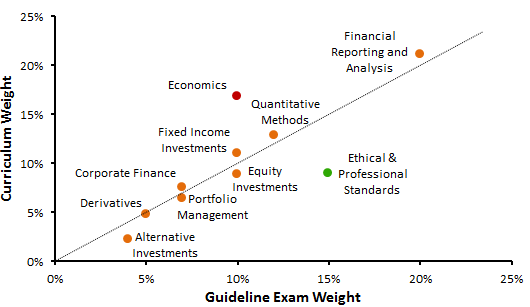Now that you are done with the dreaded financial reporting and analysis (FRA) topic it is time for a big pat on the back. If you have followed the instructions so far, you have mastered more than half of the curriculum including the crucial Ethics and FRA topics. You should be in good shape. Please make sure that you update your week 8 progress report with your achievements.
We discuss this in more depth elsewhere on the site, but basically the below scatter plot depicts the relationship between expected exam weight and curriculum weight for the 10 CFA® exam level 1 topics. As you can see FRA is the “heaviest” topic area on both measures, whereas Ethics is by far the topic area with the largest expected exam weight (15%) relative to its curriculum weighting (9.2%). You cannot afford to “mess up” any of these two, conversely a solid score on both topic areas will help propel you towards the desired exam result.

Source: Financial Exam Academy (Based on the CFA® exam – level 1 curriculum – June 2016 Exam)
The week to come:
This week we are covering the first 5 readings in the corporate finance topic, the topic area shares space with portfolio management in curriculum book number 4, and contains 6 relatively short readings (between 28 and 44 pages each). The topic area is focused on the financial decisions of corporations in their pursuit to maximize shareholder value and in some cases (depending on corporate governance framework) broader stakeholder value as well.
The first 2 readings (capital budgeting and cost of capital) feature fairly heavily in terms of the number of LOS end of chapter questions compared to the remaining readings. There is obviously no guarantee that the readings will be skewed in the same direction in terms of their weighting on the exam day, but it probably will not hurt paying extra attention to the first 2 readings.
We are going to use our standard study approach to master the corporate finance readings:
- Write down the LOS on flashcards so that you have them handy, and actively seek out and write down the answers on the flip side (with the page number) as you progress through each individual reading (It is crucial that you manage to focus on what is important in this reading). Also as you progress through the reading write down any key concepts or formulas that you come across on individual flash cards framed as a question, write the answer and page number on the flipside of the flashcards (for future reference). Once done have a flick through your newly created flashcards and revise and make a note of those that you struggle with in your question log.
- Answer all of the end of chapter questions in the underlying curriculum after completing each reading (There are 115 end of chapter questions in the 5 readings, this should take about 3 hours combined). As you answer the questions make a note of the questions that challenge you (especially if you need to guess the answer) in your question log. Review your answers thoroughly and add any additional questions that you answered incorrectly to your question log. You will now have a complete list of the toughest questions in each reading seen from your perspective.
- Wait a day after you have finished each reading and attempt only the flashcards and EOC questions from your question log, revise your answers and make a note of those you are still strugglig with in your question log. Repeat this process for as many days as required until you have mastered all.
By the way, if you are doing targeted practice tests for any of the topics that you have already covered (like e.g. FRA) and are concerned about your scores, please don’t linger around these topics for now. Just make a note of it and you can pick up on your weak areas during revision time in the last weeks before the test. It is very important that you stick to your schedule so that you don’t run out of time and invade the last 6 weeks designated for revision.
Please update your week 9 progress report with your achievements from this week.
In week 10 we are completing Corporate Finance and initiating Portfolio Management.
